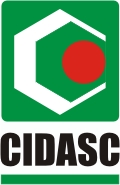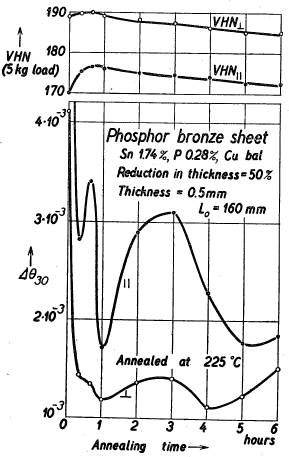T0900368V2 11 AUG 2009 DATE 11 AUG 2009 LIGO
T0900368V2 11 AUG 2009 DATE 11 AUG 2009 LIGO
Date:
T0900368-v2 11 Aug 2009
|
Date: |
11 Aug 2009 |
|
LIGO Number |
T0900368-v2 |
|
Subject: |
Allowable Bake Temperature for UHV Processing of Copper Alloys |
|
Author: |
Dennis Coyne |
Revision v1: Initial release with guidance on phosphor bronze.
Revision v2: Revised to include guidance on copper and other copper alloys (manganese bronze, copper beryllium, aluminum bronze, brass)
1Introduction
The bake temperature for removing (or accelerating the outgassing of) surface contaminants should be as high as possible without causing damage to the part. However baking at elevated temperature can in general cause degradation of the hardness and strength (temper) of a material. An elevated temperature bake can also cause internal stress relaxation and associated distortion. The purpose of this note is to establish a safe temperature for either air, or vacuum, baking of copper alloy parts. Typical LIGO Ultra-High Vacuum (UHV) preparation practice is to either vacuum bake1 for 48 hrs or air bake2 for 24 hrs to a maximum of 200C (based on oven limitations).
2Copper and Copper Alloys
For copper and copper alloys creep, stress relaxation and diminishing stress rupture strength are factors of concern above 150F3. Copper alloys frequently are used at temperatures up to 480F. The range between 480F and 750F is considered very high for copper alloys, since copper and many of its alloys begin to oxidize slightly above 350F and protection may be required. Bronzes containing Al, Si, and Be oxidize to a lesser extent than the red copper alloys.
It is recommended that the LIGO UHV preparation guidance4 include the following stipulations (for all materials, including copper alloys):
[1] For design applications where dimensional control is extremely important or tolerances are exceedingly tight, it is the responsibility of the design engineer to (a) establish a basis for baking parts at temperatures lower than the default temperatures recommended herein, and (b) get a waiver for a lower temperature bake from the LIGO Vacuum Review Board.
[2] Material certifications must be obtained for all materials. All materials must comply with the limits set on high vapor pressure elements defined in L080072-005.
3Elemental Copper and OFHC Copper
Copper and Oxygen Free High Conductivity (OFHC) copper should be able to sustain bake temperatures in vacuum (or a non-oxidizing atmosphere) up to 200C without compromising their properties. However, as mentioned above, stress relaxation may occur and cause some deformation of the part. For dimensionally critical applications, or applications with high residual stress, a lower bake temperature should be considered. In air, the maximum bake temperature should be 175C to minimize oxidation.
Copper (including OFHC copper) is an acceptable LIGO UHV material. It should be vacuum baked at 200C for 48 hrs as part of its cleaning preparation. If circumstances call for air baking (not the preferred method), then the bake temperature should be limited to 175C for 24 hrs.
4Manganese Bronzes
The manganese bronzes are also known as the high strength yellow brasses and leaded high-strength yellow brasses. These alloys contain zinc as the principal alloying element (typically 20 – 25%) with smaller amounts of iron, aluminum, manganese, nickel, and lead present.
Due to the high zinc content manganese bronzes, or brass, is not an acceptable LIGO UHV material.
5Copper Beryllium
Copper beryllium refers to a family of copper-base alloys containing beryllium and cobalt or nickel which cause the alloys to be precipitation hardenable. This alloy is suitable for parts requiring high strength, good wear, and corrosion resistance. Due to its high strength, copper beryllium is also useful as a spring material. Copper beryllium is also available in static and centrifugal cast form but is generally used as wrought shapes, such as extrusions, forgings, and mill shapes.
The maximum service temperature for C17200 copper beryllium products is 500F for up to 100 hours. Precipitation hardened alloys such as copper beryllium, retain strength up to their aging temperatures of 500F to 750F.
Copper beryllium in wrought form (not a casting) is an acceptable LIGO UHV material. It should be vacuum baked at 200C for 48 hrs as part of its cleaning preparation. If circumstances call for air baking (not the preferred method), then the bake temperature should be limited to 175C for 24 hrs.
6Aluminum Bronze
Aluminum bronze alloys, especially those with nickel, silicon, and manganese over 2 percent, respond to heat treatment, resulting in greater strength, and higher galling and fatigue limits than manganese bronze. Aluminum bronze is used in the static and centrifugal cast form or parts may be machined from wrought rod and bar stock.
Some aluminum bronze alloys include high vapor pressure elements such as zinc (Zn), phosphorous (P) and lead (Pb). These alloys must comply with the limits established in L080072-00; Most alloys should comply.
Aluminum bronze in wrought form (not a casting) is an acceptable LIGO UHV material. It should be vacuum baked at 200C for 48 hrs as part of its cleaning preparation. If circumstances call for air baking (not the preferred method), then the bake temperature should be limited to 175C for 24 hrs.
7Phosphor Bronze
Phosphor bronze, also known as tin bronze, is a relatively low strength alloy. It is generally supplied as a static (sand) casting or centrifugal casting (tubular shapes from rotating graphite molds). Phosphor-Bronze may be used for LIGO components in the Ultra-High Vacuum (UHV) system. However due to concern for outgassing from the high vapor pressure elements within the alloy, the LIGO Vacuum Review Board (VRB) has stipulated6 that:
Phosphor-Bronze alloys with P <= 0.35 %, Pb <= 1%, Zn <= 1% are acceptable for UHV service at 1 m or more from any optics, when the surface area is limited to ~1000 cm2 with sufficient justification (i.e. no reasonable alternate materials/parts). However these parts must be air baked (not vacuum baked) and require FTIR (not RGA) qualification.
Alloys of tin and copper are typically known as phosphor-bronzes since in the casting of these alloys, it is typical to add 0.03 to 0.4 per cent of phosphorous as a deoxidizer. Typically commercial wrought phosphor-bronzes do not contain more than 10 per cent of tin. The two most common alloys contain 5% (grade A) and 8% (grade C) of tin and are typically used for springs and electrical contacts.
7.1.Temperature Dependence
Curves of phosphor-bronze property changes with annealing temperature7,8,9 Indicate that short duration (~1 hr) annealing up to 250C has no more effect on the hardness, as measured by the Vickers Hardness Number (VHN), than an age annealing at ~room temperature (compare Figure 2 and Figure 4).
Even a low temperature (100 – 150C), short duration (1 hr) bake can cause an appreciable decrease in the creep amplitude (Figure 1). However, the creep amplitude for short duration annealing is not increased until the anneal temperature is > 350C. The only long duration elevated temperature data that I could find (Figure 3) seems to indicate that variation in creep and VHN are either close to asymptotic values, or unlikely to change dramatically even after 6 hrs at 225C.

Figure 1: Effect of Annealing for 1 Hour on a Measure of the Plastic Deformation or Creep due to Bending (30) in Phosphor-Bronze Sheet with 1.74% Sn. (The plastic deformation measure is defined in Reference Error: Reference source not found; It is basically the permanent set in slope at the end of a cantilevered beam after exposure to 30 kg/mm2 stress.)

Figure 2: Effect of Annealing for 1 hour on the Vickers Hardness Number (VHN) in Phosphor-Bronze Sheet with 1.74% Sn.
Other relevant information:
For phosphor-bronze a “low temperature stress relief anneal” is between 200 – 300C (duration unspecified)10. Additionally C510, C511 and C521 all have adequate resistance to stress relaxation11 when heated to 125C for 3000 hrs.
A data sheet12 for Cu Sn5 (0.02 – 0.40 % P) indicates that the stress relieving temperature range is 200 – 350C.
Phosphor Bronze (strip form) does not withstand elevated temperatures very well13 and should not be used in service above 225F (107C), even after stress relieving treatment at 325 to 350F (163-177C).
|
|
|
|
Figure 3: Effect of Annealing at 225C on VHN and 30 in Phosphor-Bronze Sheet with 1.74% Sn. |
Figure 4: Effect of Ageing at 10C on VHN in Phosphor-Bronze Sheet with 10% Sn. |
7.2.Oven Atmosphere
The purpose of baking a part with high vapor pressure elements in its alloy is to prevent plating the oven with the outgassed elements and then subsequently plating other parts that are baked in the oven. A gaseous medium acts as a buffer to prevent plating. In addition, the oxygen in air can act to more readily remove hydrocarbons from the surface. However, at elevated temperatures, the oxygen in air can lead to oxide films. While these oxide films are not deleterious to the UHV environment, they can make judging the cleanliness of the part difficult due to (potentially non-uniform) discoloration. At a low temperature (<200C) bake, this oxidation should be rather minimal.
Although hydrogen embrittlement can occur in copper and copper alloys, it will not do so at an appreciable rate unless the temperature is > 400C.
7.3.Conclusion for Phosphor Bronze
Phosphor-Bronze parts are acceptable for LIGO UHV service when not used in close proximity to the optics, with limited surface area and with sufficient justification (i.e. no reasonable alternate materials/parts). Phosphor-bronze parts should be air baked at 200C for 24 hours as part of the UHV preparation process. If there are design or part processing considerations that dictate a lower temperature bake, it is the responsibility of the design engineer to make these considerations known in a waiver request to the VRB.
1 Appendix A of “LIGO Vacuum Compatibility, Cleaning Methods and Qualification Procedures”, LIGO-E960022-B
2 Section 5.5.3 of B. Weinstein, D. Coyne, LIGO Seismic Isolation System: Fabrication Process Specification, LIGO-E970063-01
3 DOT/FAA/AR-MMPDS-01, Metallic Materials Properties Development and Standardization (MMPDS), Jan 2003.
5 L080072-00, Limits to high vapor pressure elements in alloys
6 J. Worden, VRB Response to L080045 (Limits to High Vapor Pressure Elements in Alloys), LIGO-L080072-00
7 R. A. Wilkins, E.S. Bunn, Copper and Copper Base Alloys: The Physical and Mechanical Properties of Copper and Its Commercial Alloys in Wrought Form, McGraw Hill Book Co., 1943.
8 K. Murakawa, “Effect of Low Temperature Annealing on Cold-rolled sheets of Phosphor Bronze”, The reports of the Institute of Science and Technology, University of Tokyo, 10 (1956), No. 1, pp.1-15
9 K. Murakawa, “Effect of Low Temperature Annealing on Cold-rolled sheets of Phosphor Bronze: Part II”, The reports of the Institute of Science and Technology, University of Tokyo, 11 (1957), No. 8, pp.85-90
10 Geoff Greetham , “Phosphor Bronze: Teaching an Old Dog New Tricks”, Copper Applications in Metallurgy of Copper & Copper Alloys, The Copper Development Association Newsletter, June 2001.
11 Ibid.
12 Wrought Materials, Copper-Tin Alloys, Tin Bronzes, Phosphor Bronzes, Cu Sn5, Copper Development Association, Data Sheet No. G3, 1971.
13 http://www.principalmetals.com/glossary/pdoc.htm
LIGO
LABORATORY Page
Tags: t0900368v2
- GRUPPENTRAINING SOZIALER KOMPETENZEN 27 BEZIEHUNGEN SCHÄTZEN SIE BITTE MIT
- UREDBA KOMISIJE (EU) ŠT …… Z DNE XXX O
- TEMELJEM ODREDBE ČLANKA 6 ODLUKE O DODJELI PROSTORA U
- HOW IT WORKS THE ORIGINAL APPARATUS BARTON’S PENDULUM CONSISTS
- LECCIONARIO DOMINICAL CREADO PARA EL MINISTERIO LATINOHISPANO DE LA
- İLAN BURSA BÜYÜKŞEHİR BELEDİYESİ BAŞKANLIĞINDAN BURSA BÜYÜKŞEHİR BELEDİYESİ DİSİPLİN
- TRADE OF ELECTRICIAN STANDARDS BASED APPRENTICESHIP THREEPHASE DISTRIBUTION BOARDS
- WORKBOOK ANSWERS OCR ALEVEL GEOGRAPHY 1 LANDSCAPE SYSTEMS
- PRACTICE QUESTIONS FOR GENERAL INTERVIEWS PERSONAL QUALITIES PLEASE
- ROMAN CATHOLIC CHURCH AND ITS VIEW OF FAMILY
- MELAHIRKAN NILAI PANCASILA JAWA POS [ SELASA 01 JUNI
- VENTANA DE ACCESO AL PROGRAMA TRAS EFECTUAR DOBLE
- IN CASE OF ABSENCE OF THE MUTUAL AGREEMENT BETWEEN
- ROCZNICA ATAKÓW 11 WRZEŚNIA NA NATIONAL GEOGRAPHIC CHANNEL 11
- INFORMACIÓN SOBRE LA PRESENTACIÓN DE PRESUPUESTOS Y FACTURAS PROFORMA
- SOL Nº 1 MARCA 2 CONTESTA OBSERVACIÓN DE FONDO
- REKONSTRUKCIJA PARKIRIŠČA NA POKOPALIŠČU MEŽICA T E H N
- PEDOMAN PELAKSANAAN PENULISAN TUGAS AKHIR PROGRAM STUDI STATISTIKA FAKULTAS
- [TITLE] N ATIONAL CONSTITUTION CENTER CLASSROOM READY RESOURCE DESTINATION
- PERALTA COMMUNITY COLLEGE DISTRICT AP 4030 ADMINISTRATIVE PROCEDURE 4030
- XIV EDYCJA NAGRODY WOJEWODY ŚWIĘTOKRZYSKIEGO „LAUR ŚWIĘTOKRZYSKI 2019” WNIOSEK
- READING TASKS THE SILVER DONKEY BY SONYA HARTNETT YEAR
- LAMMANA AND GLASTONBURY LAMMANA AND GLASTONBURY GLASTONBURY
- FICHA DIAGNÓSTICO LEGALAMBIENTAL PLAN INTEGRAL DE SEGURIDAD ESCOLAR PLAN
- FACULTAD DE CIENCIAS DEL MAR ESCUELA SUPERIOR POLITECNICA DEL
- GERENCIA DE ATENCION PRIMARIA DE LEÓN UNIDAD DOCENTE MULTIPROFESIONAL
- CONSENTASSENT FORM TEMPLATE PREAMBLE IT IS IMPORTANT THAT RESEARCH
- CISCO SMART+CONNECTED COMMUNITIES MEDIA BACKGROUNDER IN FEBRUARY 2009 CISCO
- PAGE 0 CONTACT JOHN SLOANE PRESS RELEASE PHONE (610)7055406
- ENGLISH LOI SUR LE MINISTÈRE DU PROCUREUR GÉNÉRAL LRO
NO TIENE DIFICULTAD LIMITACIÓN LEVE LIMITACIÓN GRAVE LIMITACIÓN MUY
ANXIETY DISORDERS 10 NAME OF DISEASE ANXIETY DISORDERS DEFINITION
600106 PREPROGRAMMING (ALGORITHMIC THINKING) INTERSESSION 2007 NAME DATE
A3 JAVNI RAZPIS ZA SOFINANCIRANJE MLADINSKIH AKTIVNOSTI 2010 SKLOP
A GENDERED READING OF CONDUCT BOOKS MARJA VAN
KARLÍN MUSIC THEATRE T HE KARLÍN THEATRE WAS BUILT
 ESTADO DE SANTA CATARINA SECRETARIA DE ESTADO DA AGRICULTURA
ESTADO DE SANTA CATARINA SECRETARIA DE ESTADO DA AGRICULTURA9EL GUIÓN CINEMATOGRÁFICO HTTPRECURSOSCNICEMECESMEDIACINEBLOQUE10INDEXHTML INTRODUCCIÓN TODA PELÍCULA TIENE UN
ESTATUTOS DE LA ASOCIACIÓN CAPÍTULO I DENOMINACIÓN CONSTITUCIÓN
 64 KRYSTYNA SZYSZKO BARBARA MOSKAL STANISŁAW STASZIC 250 ROCZNICA
64 KRYSTYNA SZYSZKO BARBARA MOSKAL STANISŁAW STASZIC 250 ROCZNICA НАУКОВОДОСЛІДНИЙ ЕКОНОМІЧНИЙ ІНСТИТУТ МІНІСТЕРСТВА ЕКОНОМІКИ УКРАЇНИ ГРИГОРОВИЧ АРКАДІЙ ВІТАЛІЙОВИЧ
НАУКОВОДОСЛІДНИЙ ЕКОНОМІЧНИЙ ІНСТИТУТ МІНІСТЕРСТВА ЕКОНОМІКИ УКРАЇНИ ГРИГОРОВИЧ АРКАДІЙ ВІТАЛІЙОВИЧProgram od 0412 do 11122011 4 25 Nedeľa
 PROBLEMAS MÁS FRECUENTES DURANTE LA SECUENCIACIÓN L A CALIDAD
PROBLEMAS MÁS FRECUENTES DURANTE LA SECUENCIACIÓN L A CALIDADEDICTE D’APROVACIÓ INICIAL DEL PROJECTE D’URBANITZACIÓ DEL SECTOR CAN
!DOCTYPE HTML PUBLIC W3CDTD XHTML 10 TRANSITIONALEN HTTPWWWW3ORGTRXHTML1DTDXHTML1TRANSITIONALDTD !
XIII DISEASES OF THE MUSCULOSKELETAL SYSTEM AND CONNECTIVE TISSUE
PÁGINAS WEB RELACIONADAS CON LA LENGUA EN LA LITERATURA
PROCEDIMIENTO MATERIA CONCURSO DE TRASLADOS CUERPO DE SECUNDARIA
 PRIJAVNICA ZA KONCERT DOMAČIH TALENTOV POSLATI NA EPOŠTO MARTINAPREGMAILCOM
PRIJAVNICA ZA KONCERT DOMAČIH TALENTOV POSLATI NA EPOŠTO MARTINAPREGMAILCOMNUMER SPRAWY NADANY PRZEZ ZAMAWIAJĄCEGO GPRRIV341182007 ZP300 URZĄD ZAMÓWIEŃ

